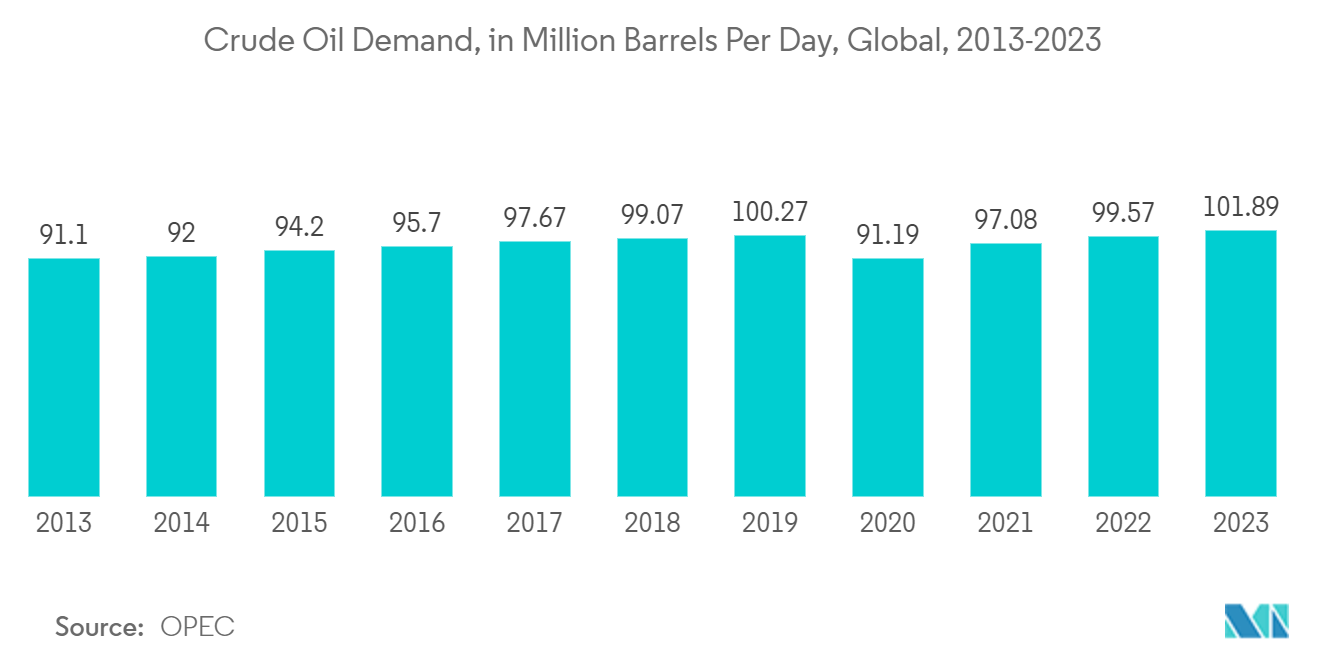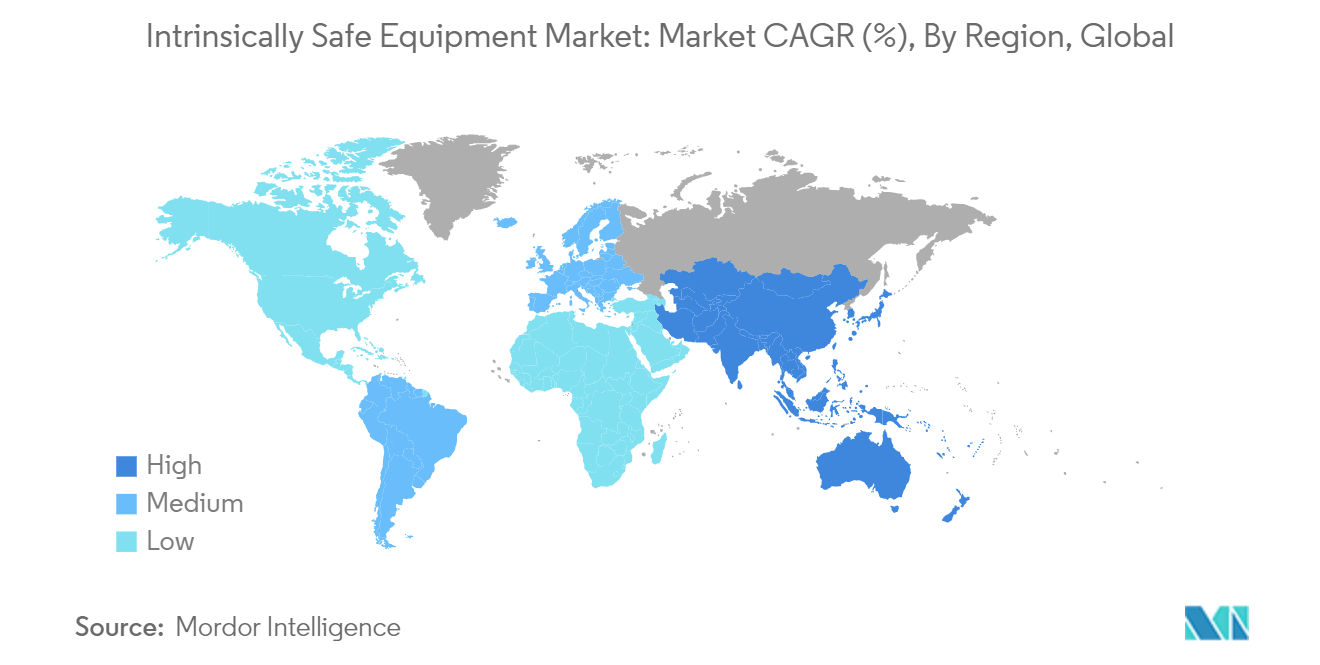Market Trends of Intrinsically Safe Equipment Industry
Oil and Gas End User Segment is Expected to Hold a Significant Market Share
- The growing safety concerns and increasing exploration activities across the industry in various regions are expected to drive market growth. In hazardous locations, such as those found in the oil and gas industry, intrinsic safety serves as a design technique to prevent explosions in electrical equipment and wiring. The intrinsically safe equipment finds significant demand in the oil and gas sector, which is one of its primary end-user markets. Governments worldwide are compelled to enforce strict safety regulations due to the industry's rising number of accidents and explosions. Furthermore, the expanding energy requirements and the growing exploration activities in offshore and onshore oil fields present a substantial opportunity for the market to establish a foothold in this sector.
- In the O&G industry, modern electrical equipment is specifically engineered to withstand the demanding conditions of various processes within the oil and gas industry, including motor controls and supports. As the utilization of electrical equipment continues to rise across the industry, there is a growing requirement for intrinsically safe equipment to mitigate the risk of explosions. In the oil and gas sector, intrinsically safe equipment is extensively employed in oil refineries, drilling rigs, and petrochemical plants to safeguard workers and prevent potential explosions.
- Similarly, in the oil and gas industry, intrinsic safety has emerged as a prevalent method for ensuring safety protection. This technique involves the use of lower voltage or power equipment, including electronics, controls, HMIs, and industrial monitors and displays. These devices are extensively utilized in this industry due to the presence of highly explosive atmospheres and flammable gases. Given the industry's susceptibility to risks, the implementation of emergency management systems has become imperative, leading to a growing demand for diverse safety standards.
- The industry's increasing investments and the rising global oil demand are projected to create employment opportunities in various countries. As a result, the market is expected to grow and prioritize safety measures for workers. According to the International Energy Agency (IEA), the global demand for crude oil was estimated to reach 101.9 million barrels per day (bpd) in 2023, surpassing the 2022 forecast by 2 million bpd. Additionally, the IEA predicts that by the end of the decade, global demand will increase by approximately eight million bpd, leading to a greater demand for offshore activities.
- Moreover, according to the report released by OPEC, the global consumption of crude oil, including biofuels, reached 99.57 million barrels per day in 2022. This figure is projected to climb to 101.89 million barrels per day in 2023 and eventually reach 109.8 million barrels per day by 2045. Additionally, the demand for diesel and gasoil is expected to rise to 30.1 million barrels per day in 2045, compared to 27.6 million barrels in 2021. These factors will contribute to increased awareness and the implementation of stricter safety regulations, placing a greater emphasis on workplace safety, thereby driving the need for various intrinsically safe equipment.
- For instance, in the industry, there is a growing trend of embracing intrinsically safe sensors to detect and react to environmental changes effectively. These sensors are extensively utilized in gas and oil facilities for various purposes, such as examining the state of pumps, filters, wellheads, and other components of pipelines. Additionally, they play a crucial role in evaluating the efficiency of above-ground pumps. Furthermore, these sensors are of great importance in monitoring inventory levels and proactively identifying potential issues before they become major concerns in the industry.

Asia-Pacific Expected to Register Major Growth
- China is one of the biggest countries in APAC, having major industries like mining, chemicals, oil and gas, process manufacturing, and others. Over the past few years, there have been significant changes in the field of intrinsically safe equipment across these industries in the region, as governments across the Chinese states have been advocating for more stringent workplace safety regulations. Moreover, increasing safety concerns owing to the increasing explosions and causalities across the industries in the region are expected to enhance the safety equipment applications.
- The demand for intrinsically safe equipment in Japan is being driven by the growing number of government regulations and increasing concerns about safety and security in the workplace, particularly due to the rise in explosion activities. An example of this is the explosion that occurred at a chemical plant in Niigata Prefecture in June 2023, resulting in the death of a contractor and injuries to two others. The industry is expected to adopt a range of safety equipment, including sensors, detectors, and others, to provide early warning of potential hazards.
- Similarly, various industries in Japan are continuously incorporating intrinsically safe equipment, including smoke detectors, sensors, transmitters, and other devices, across different sectors. This is particularly evident in industries such as power, manufacturing, mining, and others, where the utilization of flammable gases or liquids is prevalent. The growing investments in these sectors are anticipated to create more opportunities for safety equipment, aiming to prevent potential explosions. For example, Japan is consistently investing in nuclear power energy and heavily relies on electricity generated from nuclear plants. The escalating activities in nuclear power generation within the region are projected to drive the market forward.
- The market studied in India is anticipated to experience a surge in demand due to the growing investments and government initiatives aimed at promoting foreign direct investments (FDIs). This is particularly relevant in the oil and gas industry, where highly explosive atmospheres and flammable gases necessitate the use of these products. As the Indian oil and gas industry expands, the government is also intensifying safety regulations, which are expected to drive the market further. Notably, organizations such as the Oil Industry Safety Directorate (OISD) play a crucial role in formulating and coordinating the implementation of self-regulatory measures to enhance safety in the Indian oil and gas industry, thereby bolstering the market's potential.
- The regions of Indonesia, Korea, and others have a significant demand for intrinsically safe equipment in the oil and gas and mining sectors. These industries are witnessing a rise in casualties and explosions, which have compelled governments in these regions to implement strict safety regulations. Additionally, the market is being driven by the growing exploration activities in these sectors.

